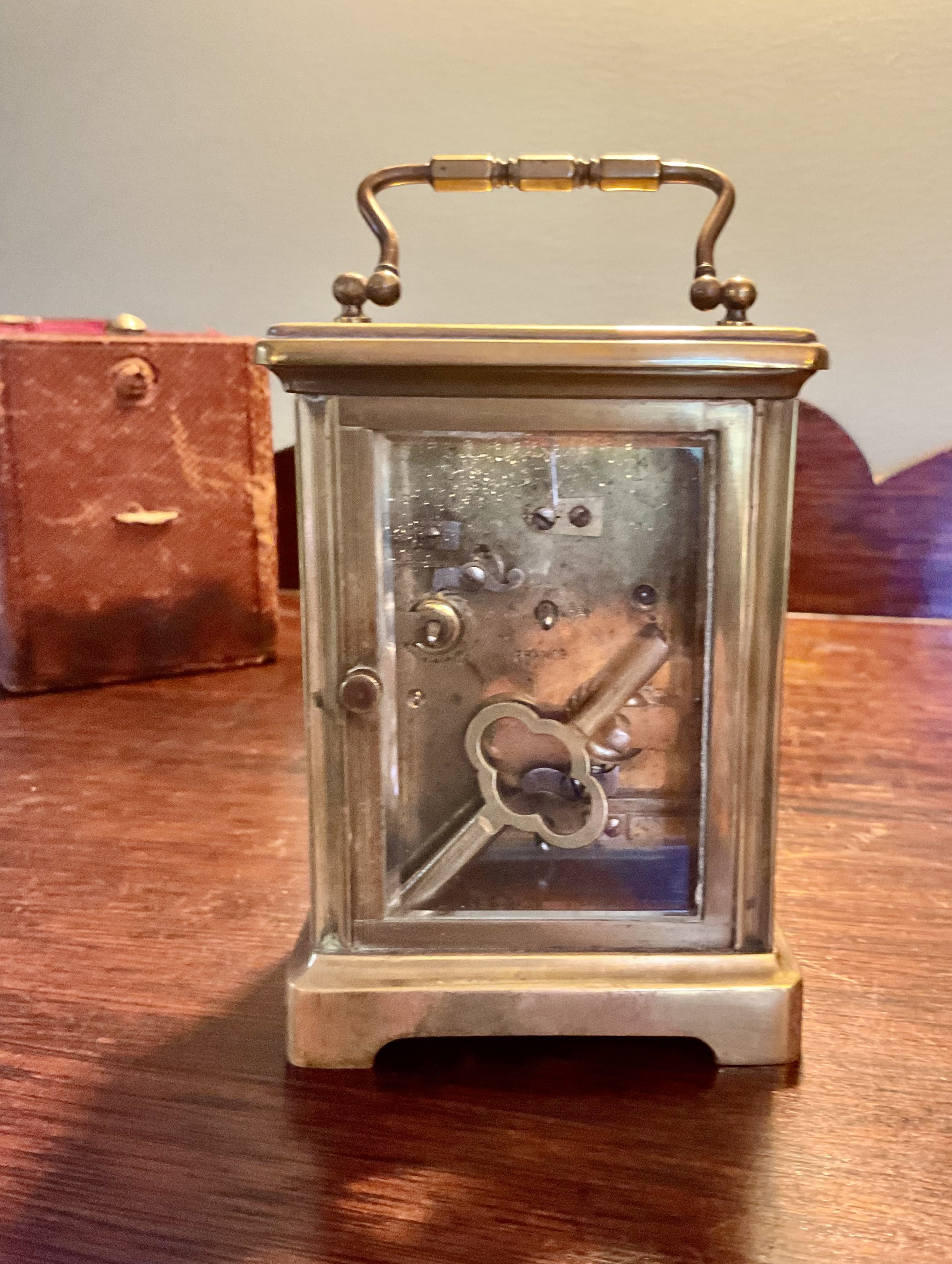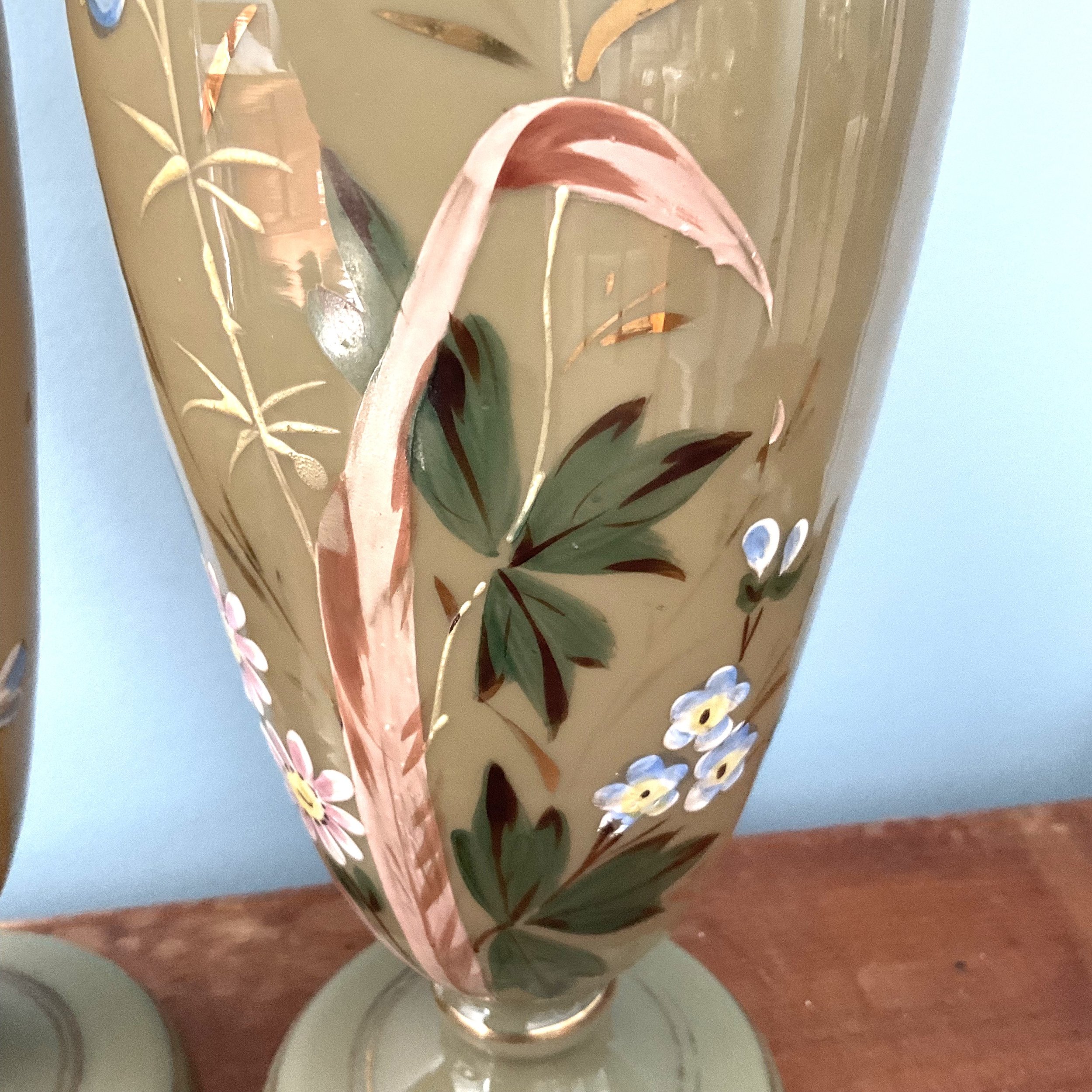 Image 1 of 9
Image 1 of 9

 Image 2 of 9
Image 2 of 9

 Image 3 of 9
Image 3 of 9

 Image 4 of 9
Image 4 of 9

 Image 5 of 9
Image 5 of 9

 Image 6 of 9
Image 6 of 9

 Image 7 of 9
Image 7 of 9

 Image 8 of 9
Image 8 of 9

 Image 9 of 9
Image 9 of 9










Charming French Antique Carriage Clock
This ornate brass carriage clock comes in a leather bound wooden box with a burgundy velvet interior. The box is in need of restoration. Complete with key, it has a bevelled glass case. Some of the numbers have faded and there appears to be only one arm. This could quite possibly be inside the clock itself. For clock lovers, this is well worth some restoration.
A carriage clock, developed in early 19th century France, was a time piece designed in such a way that it could be used on a journey. The carriage clock was controlled by a spring-driven mechanism which replaced the pendulum. The first carriage clock was invented by Abraham-Louis Breguet for the Emperor Napoleon in 1812. During the 19th century travellers used carriage clocks when making their trip by horse drawn carriage. These clocks were also known as Officer’s clocks due to the fact that armies on the move often used them. A distinctive feature of the carriage clock was the handle which was often quite ornate. Cases were often made of wood, metal or silver.
The outer wooden case measures 13 cms in height, 11 cms in length and 9 cms in width. The clock itself is 11 cms in height, 8 cms in length and 6 cms in width.
This ornate brass carriage clock comes in a leather bound wooden box with a burgundy velvet interior. The box is in need of restoration. Complete with key, it has a bevelled glass case. Some of the numbers have faded and there appears to be only one arm. This could quite possibly be inside the clock itself. For clock lovers, this is well worth some restoration.
A carriage clock, developed in early 19th century France, was a time piece designed in such a way that it could be used on a journey. The carriage clock was controlled by a spring-driven mechanism which replaced the pendulum. The first carriage clock was invented by Abraham-Louis Breguet for the Emperor Napoleon in 1812. During the 19th century travellers used carriage clocks when making their trip by horse drawn carriage. These clocks were also known as Officer’s clocks due to the fact that armies on the move often used them. A distinctive feature of the carriage clock was the handle which was often quite ornate. Cases were often made of wood, metal or silver.
The outer wooden case measures 13 cms in height, 11 cms in length and 9 cms in width. The clock itself is 11 cms in height, 8 cms in length and 6 cms in width.
This ornate brass carriage clock comes in a leather bound wooden box with a burgundy velvet interior. The box is in need of restoration. Complete with key, it has a bevelled glass case. Some of the numbers have faded and there appears to be only one arm. This could quite possibly be inside the clock itself. For clock lovers, this is well worth some restoration.
A carriage clock, developed in early 19th century France, was a time piece designed in such a way that it could be used on a journey. The carriage clock was controlled by a spring-driven mechanism which replaced the pendulum. The first carriage clock was invented by Abraham-Louis Breguet for the Emperor Napoleon in 1812. During the 19th century travellers used carriage clocks when making their trip by horse drawn carriage. These clocks were also known as Officer’s clocks due to the fact that armies on the move often used them. A distinctive feature of the carriage clock was the handle which was often quite ornate. Cases were often made of wood, metal or silver.
The outer wooden case measures 13 cms in height, 11 cms in length and 9 cms in width. The clock itself is 11 cms in height, 8 cms in length and 6 cms in width.
Not suitable for delivery via Australia Post. Collection by appointment. Please make contact if you would like to arrange another type of delivery. Free delivery to some Melbourne metropolitan areas can be arranged.






































